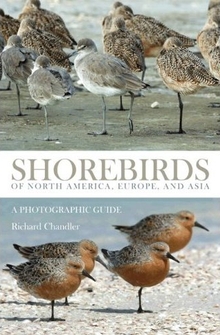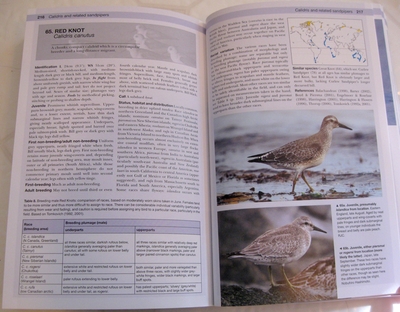Reviewed by Grant McCreary on October 7th, 2009.
Shorebirds…birders seem to either love them or hate them. Or just ignore them altogether! There’s nothing wrong with the birds, they’re just hard to identify. But not impossible, especially with the right guide (or guides, more than likely). So is this one worthy of joining you at your nearest shorebird hotspot?
Shorebirds of North America, Europe, and Asia: A Photographic Guide covers the shorebirds of, you guessed it, North America, Europe, and Asia. However, while it covers the entirety of the first two continents, it doesn’t quite get all of Asia. It also includes the northern portion of Africa. Basically, it covers just about the entire northern hemisphere (and indeed is published under the title Shorebirds of the Northern Hemisphere in Europe). Regardless, it includes 134 species of shorebirds.
The species accounts are very attractive, with a nice use of color and images. They start with the English and scientific names along with a brief one or two sentence description of the species. For example, the Spoon-billed Sandpiper is introduced thusly: “A small east Asian sandpiper with a unique spatulate-tipped bill. Endangered.” The main text follows, and photographs conclude the accounts.
The account text consists of the following sections:
- Identification – Size; ID keys; In flight; Feeding
- Ageing – separate descriptions of each age class
- Call
- Status, Habitat, and Distribution
- Racial Variation and Hybridization
- Similar Species
- References – source material and further reading
As you can see, the text is mostly identification related. Combined with the photo captions, it does a good job of telling you what you need to look for. However, there is little beyond that. There is very little relating to behavior, for example, except as it pertains to identification. But I was pleased to see that some of the more distinctive behavioral traits, such as the tail bobbing of Spotted Sandpipers and “wave chasing” of Sanderlings, was mentioned.
The range maps use three colors to indicate breeding, wintering, and permanent ranges. The maps are a good size, and zoomed in appropriately on the actual range. It’s very nice to find that the maps show the entire worldwide range for each species. However, I am displeased about two aspects of the maps. For such a strongly migratory group of birds, it’s unfortunate that the migratory range isn’t indicated. Some of these species are encountered by birders almost exclusively on migration, so it’s regrettable that’s not shown on the maps. Even more egregious is the lack of political boundary lines. Personally, I find maps that lack them much less useful.
And now we get to the most important part – the photographs. They are, in a word, great. For the most part, they show single birds of all the various plumage types, broken down by age, gender, and race. Most are even shown in flight, or at the very least, stretching their wings. Anywhere from two to twenty photos of each species are included, ensuring that each species gets as many as necessary. The layout is flexible, which allows the photos to be sized and placed as best suits them. Not only does it help the reader get a better look at the pictures, it makes the entire guide more visually appealing.
Each photo is captioned with the age and sex of the bird (where known), the location and month the photo was taken (bravo!), and the photographer’s name. Additionally, most include notes on the relevant field marks depicted in the image. While you should always refer to the account text to get the full story, you can learn much about the identification of the species just by reading the captions.
Finally, we go back to the beginning of the book and the fairly extensive introduction. Plumage and molt is given a decent overview, which includes the expected topography diagrams. Shorebird behavior is also touched upon, focusing especially on feeding.
My biggest issue with this guide is that the species name is only given in the account header and (occasionally) in the main text. This may not seem like much of a problem, but since the photos follow the text, most of them are on separate pages than the header. Thus, for the majority of the pictures, there is no indication on that page of the species you’re looking at! For instance, if you find yourself on the last page of the Kentish Plover account and want to know what bird it is, you would have to flip back three pages to find out. This has been a constant annoyance to me while looking through this guide. And the shame is that it would have been very easy to rectify. Each page has a color bar along the top indicating the group this species belongs to (e.g. “Snipes”, “Calidris and related sandpipers”). There is plenty of room to include the species name in this bar.
Recommendation
There’s no question this guide is useful for sorting out shorebirds. No, the real question is how it stacks up to other shorebird guides. Here is a comparison of the most recent shorebird guides, including this one. But in case you don’t want to read all that, here’s the conclusion: The Shorebird Guide (my review) is still, by far, the best guide for shorebirds.
But that doesn’t mean there isn’t a place for this guide on your shelf. You really can’t have too many shorebird references. This is an ideal second guide for North American birders since it contains so many potential vagrants from Europe and Asia. And this is almost a must-have for European and Asian birders.
Disclosure: I get a small commission for purchases made through links in this post.
Disclosure: The item reviewed here was a complementary review copy provided by the publisher. But the opinion expressed here is my own, it has not been influenced in any way.






Comment